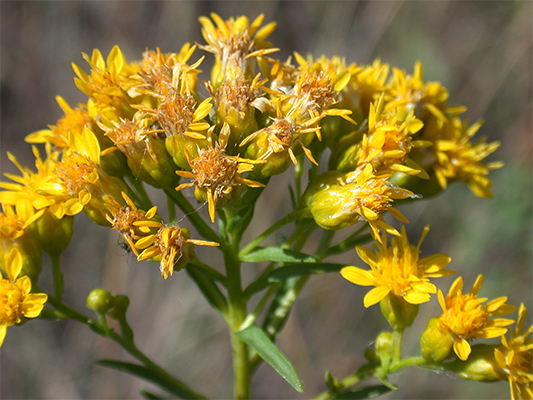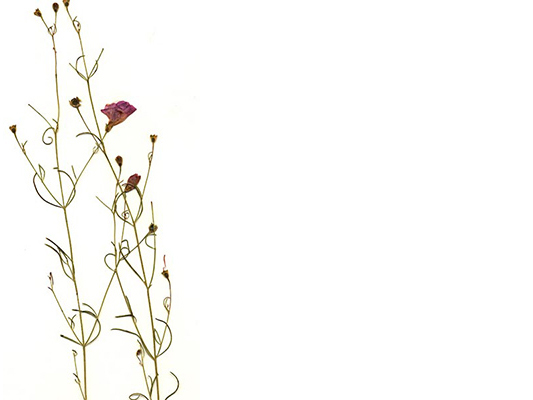Gattinger’s Agalinis and Houghton’s Goldenrod

Photo credit: Wasyl Bakowsky

Photo credit: Dr. Eugene Wofford
Species information
The following is a report on progress made towards the protection and recovery of Gattinger’s Agalinis (Agalinis gattingeri) and Houghton’s Goldenrod (Solidago houghtonii) in Ontario from 2007 to 2020, based on Ontario’s species-specific recovery policy. This report meets the legislative requirement for a review of progress under the Endangered Species Act, 2007 (ESA or “the Act”). Gattinger’s Agalinis is listed as endangered, and Houghton’s Goldenrod is listed as threatened on the Species at Risk in Ontario (SARO) List under the ESA.
Gattinger’s Agalinis has been classified as a species at risk since 2004. It was originally classified as an endangered species and was listed as such under the ESA when it came into force in June 2008.
Houghton’s Goldenrod was listed as a threatened species under the ESA when the Act came into force in June 2008.
Gattinger’s Agalinis and Houghton’s Goldenrod have been protected from being killed, harmed, harassed, captured or taken since 2008.
In addition, the habitat of Gattinger’s Agalinis and Houghton’s Goldenrod has been protected from being damaged or destroyed since 2013.
The species-specific recovery policy for Gattinger’s Agalinis and Houghton’s Goldenrod, known as the Government Response Statement (GRS), was published in 2016 and includes the government’s recovery goal for the species and the actions and priorities it intends to lead or support to help achieve that goal. The protection and recovery actions for the species, described in the GRS, are based on advice provided in their respective recovery strategies (Gattinger’s Agalinis and Houghton’s Goldenrod). As legislated in the Act, the purpose of this review is to report on progress made towards implementing the protection and recovery actions in the GRS. The review can also help identify opportunities to adjust and adapt the implementation of protection and recovery actions to achieve the recovery goal for the species.
Gattinger's Agalinis
Houghton's Goldenrod
Further information about Gattinger’s Agalinis and Houghton’s Goldenrod, including the threats that they face, and actions being taken to help protect and recover these species is available on the Government of Ontario webpages for Gattinger’s Agalinis and Houghton’s Goldenrod. A summary on the progress towards the protection and recovery of Gattinger’s Agalinis and Houghton’s Goldenrod and an annual update on the broader species at risk program (i.e. the Introduction to the 2021 Review of Progress report) is available on the Review of Progress towards the Protection and Recovery of Ontario’s Species at Risk webpage.
Snapshot: Progress towards the protection and recovery of Gattinger’s Agalinis and Houghton’s Goldenrod
Progress towards meeting the recovery goal
- The recovery goal in the Government Response Statement (GRS) for Gattinger’s Agalinis and Houghton’s Goldenrod in Ontario is to “maintain self-sustaining populations across their Ontario distribution by reducing threats to the species and their habitats to allow for natural increases.”
- Progress has been made towards implementing several of the government-led actions. Progress has been made towards implementing two of the government-supported recovery objectives and two of the associated actions. Examples of progress include:
- completing a prescribed burn in Gattinger’s Agalinis habitat
- constructing a boardwalk to prevent pedestrian and vehicular harm to Gattinger’s Agalinis
- controlling invasive Phragmites (Phragmites australis ssp. australis) at or adjacent to Gattinger’s Agalinis and Houghton’s Goldenrod populations
In alignment with the GRS recommendations more work is required to better understand the population dynamics and biology of Gattinger’s Agalinis and Houghton’s Goldenrod.
Occurrences and distribution
- Twenty-four populations of Gattinger’s Agalinis and thirty-eight populations of Houghton’s Goldenrod have been documented in Ontario. Currently, twenty populations of the former and thirty-five of the latter are considered to be extant , whereas the rest are considered historical
footnote 1 . Since 2008, the status of two populations of Gattinger’s Agalinis changed from extantfootnote 2 whereas the rest are considered historicalfootnote 3 . Since 2008, the status of two populations of Gattinger’s Agalinis changed from extant to historical based on the date that it was last observed. Two populations of Gattinger’s Agalinis have been newly identified since 2008.
Government-supported stewardship projects
- Through the Species at Risk Stewardship Program, the Government of Ontario has enabled its stewardship partners to undertake eight projects (by providing $387,538 in funding) that have supported the protection and recovery of multiple species at risk, including Gattinger’s Agalinis and Houghton’s Goldenrod.
- The government’s support helped its stewardship partners to involve 324 individuals who volunteered 3,446 hours of their time towards protection and recovery activities for species at risk, including Gattinger’s Agalinis and Houghton’s Goldenrod. The estimated value of these voluntary contributions, as well as additional funding and in-kind support, is $724,789.
- Stewardship partners reported that through their actions approximately 57 hectares of habitat were enhanced for Gattinger’s Agalinis and Houghton’s Goldenrod and other species at risk that inhabit the same ecosystems.
- Stewardship partners reported providing outreach on multiple species at risk, including Gattinger’s Agalinis and Houghton’s Goldenrod, to 340,548 individuals.
Supporting human activities while ensuring appropriate support for species recovery
- Twenty-two activities have been registered for the two species. The activities were registered under ‘‘Threats to health and safety, not imminent’ (section 23.18) and “Transition – development ongoing when species first listed” (section 23.13) under Ontario Regulation 242/08 of the ESA.
Reporting on the progress towards the protection and recovery of Gattinger’s Agalinis and Houghton’s Goldenrod
Recovery goal
The government’s goal for the recovery of Gattinger’s Agalinis and Houghton’s Goldenrod is to “maintain self-sustaining populations across their Ontario distribution by reducing threats to the species and their habitats to allow for natural increases.”
The implementation of government-led and government-supported actions demonstrates progress towards reaching the desired objectives and the recovery goal set out in the GRS.
Progress towards implementing government-led actions
Progress has been made towards implementing several government-led actions identified in the GRS. Common actions for the government to lead as it works towards achieving a species’ recovery goal include:
- Continue to implement the Ontario Invasive Species Strategic Plan to address the invasive species (e.g., Phragmites) that threaten Gattinger’s Agalinis and Houghton’s Goldenrod.
- Educate other agencies and authorities involved in planning and environmental assessment processes on the protection requirements under the ESA.
- Encourage the submission of Gattinger’s Agalinis and Houghton’s Goldenrod data to the Government of Ontario’s central repository at the Natural Heritage Information Centre.
- Undertake communications and outreach to increase public awareness of species at risk in Ontario.
- Protect Gattinger’s Agalinis and Houghton’s Goldenrod and their habitat through the ESA.
- Develop direction to provide greater clarity to proponents and partners on the areas of general habitat protected under the ESA for plant species at risk.
- Support conservation, agency, municipal and industry partners, and Indigenous communities and organizations to undertake activities to protect and recover Gattinger’s Agalinis and Houghton’s Goldenrod through funding, agreements, permits (including conditions) and/or advisory services.
- Encourage collaboration and establish and communicate annual priority actions for government support in order to reduce duplication of efforts.
Additionally, the government has made progress on the following species-specific action:
- Continue to manage the habitat of Gattinger’s Agalinis and Houghton’s Goldenrod in provincially protected areas to maintain the ecological integrity of their habitats and to minimize the threat of recreational pressures and impacts.
Key progress made towards implementing these actions is described in the following sections.
Specifically, Ontario Parks has erected gates and signage to prevent harm to Houghton’s Goldenrod and the damage of its habitat by the unauthorized use of motorized vehicles at Cabot Head Provincial Nature Reserve.
Ontario’s Invasive Species Act
The GRS for Gattinger’s Agalinis and Houghton’s Goldenrod indicates that invasive species (e.g. Phragmites) pose a threat to the survival and recovery of the species in Ontario. The Ontario Invasive Species Strategic Plan, 2012 and the Invasive Species Act, 2015 provide the policy and legislative framework to prevent new invaders from arriving and surviving in Ontario; to slow and where possible reverse the spread of existing invasive species, and to reduce the harmful impacts of existing invasive species, including impacts on species at risk. This framework may support the implementation of actions to reduce the threats from invasive species.
Occurrences and distribution
Twenty-four populations of Gattinger’s Agalinis and thirty-eight populations of Houghton’s Goldenrod have been documented in Ontario. Twenty populations of the former and thirty-five populations of the latter are considered to be extant, and the remaining populations of both are considered to be historical. The extant populations are located in the following upper tier municipalities of Ontario: Algoma District, Bruce County, Lambton County and Manitoulin District. Many of them occur on lands of Indigenous peoples including the Walpole Island First Nation, the Neyaashiinigmiing First Nation, the Wiikwemikoong Unceded Territory, the Aundeek Omni Kaning First Nation, the M'chigeeng First Nation, the Sheguiandah First Nation, the Sheshegwaning First Nation, the Whitefish River First Nation and the Zhiibaahaasing First Nation.
Since 2008, the government’s central repository at the Natural Heritage Information Centre (NHIC) has received 117 records of Gattinger’s Agalinis and 46 records of Houghton’s Goldenrod. These records are based on observations made up to and including 2019 that come from a variety of sources.
These records have refined knowledge of where the two species have occurred and presently occur. They indicate that two previously undocumented populations of Gattinger’s Agalinis were discovered respectively in 2011 and 2014.
The records have also provided additional information on the two species’ population sizes and the threats posed to them. Threats from all terrain vehicle use and the spread of invasive plants have been documented in some populations of both Gattinger’s Agalinis and Houghton’s Goldenrod. While six populations of Gattinger’s Agalinis are described as having over a thousand or thousands of plants, five are described as having only thirty to fifty plants in total. Similarly, in the case of Houghton’s Goldenrod, five populations are described as having over a thousand or several thousand plants, but one is described as consisting of only ten plants, and there are no abundance data for many.
The two newly-identified populations of Gattinger’s Agalinis are the result of search effort expended by a biological consultant and Ministry of Northern Development, Mines, Natural Resources and Forestry (NDMNRF) biologists. These populations probably do not represent an actual increase in the number of populations, but rather increased knowledge about the distribution of the species.
It is possible that there are observations of Gattinger’s Agalinis and Houghton’s Goldenrod that have not been submitted to the government. Encouraging the submission of observations of this species is included in the GRS as a government-led action. Submission of species observations increases our knowledge of where they occur and can play an important role in assessing the viability of species populations.
Everyone is encouraged, or may be required by an authorization or approval to submit observations of Gattinger’s Agalinis and Houghton’s Goldenrod , and any other species at risk observed, to the NHIC for incorporation into the provincial record of observations. Observations may now be submitted to NHIC via the Rare Species of Ontario project in iNaturalist.
-
117observations of Gattinger's Agalinis were submitted to the NHIC since 2008
-
46observations of Houghton's Goldenrod were submitted to the NHIC since 2008
Government-supported stewardship projects
An important government-led action in the GRS for Gattinger’s Agalinis and Houghton’s Goldenrod is to support partners to undertake activities to protect and recover the species. Through the Species at Risk Stewardship Program the government has supported eight projects ($387,538) intended to contribute to the protection and recovery of Gattinger’s Agalinis and Houghton’s Goldenrod
The remainder of this section highlights a project supported through the Species at Risk Stewardship Program as well as the corresponding government-supported recovery actions for the species.
From 2017 to 2019, the Manitoulin Phragmites Project, led by Winter Spider Eco-Consulting, improved species at risk habitat on Manitoulin, Cockburn and Great Duck Islands in Lake Huron. The project had two main goals. The first was to control the spread of the invasive Phragmites in the habitats of Gattinger’s Agalinis, Houghton’s Goldenrod, Pitcher’s Thistle (Cirsium pitcheri), and 10 other species at risk. The second was to teach people across the Manitoulin Region to perform invasive species control methods, so that the benefits would be maintained after the project ends.
For Gattinger’s Agalinis, the project controlled Phragmites over an area of 4.5 hectares immediately adjacent to occupied habitat at Freer Point and in Wiikwemkoong Unceded Territory. At the end of 2019, Phragmites was under control at both locations with the exception of small patches remaining in an interior marsh that borders the habitat at Freer Point.
For Houghton's Goldenrod, the project implemented control measures at 14 locations on Manitoulin Island and Cockburn Island over a total of 67 hectares, of which about 55 hectares was occupied habitat.
The Manitoulin Phragmites Project hosted Phragmites Week in the third week of July each year, hosting events to teach Phragmites control techniques and engage community members in communal control efforts. More than 100 people volunteered in the fight against this invasive plant during the summer of 2019. The project aims to reduce Phragmites abundance to a low level that can be maintained with a small amount of annual maintenance.
At the end of 2019, project participants had undertaken the control of Phragmites invasions at more than 80 sites, achieving control or eradication in at least 107 hectares of species at risk habitat including the previously mentioned 55 hectares of Houghton’s Goldenrod habitat and habitat of 11 other species at risk. The Manitoulin Phragmites Project continues to be funded by the Species at Risk Stewardship Program through 2022. As of October 2020, this project has brought Phragmites under control in more than 252 hectares of habitat of 13 different species at risk.
Species at Risk Stewardship Program
-
 8
8projects included Gattinger's Agalinis and Houghton's Goldenrod
-
 $387,538
$387,538for multi-species projects that included Gattinger's Agalinis and Houghton's Goldenrod
-
 $724,789
$724,789in additional funding and in-kind support
-
 324
324volunteers
-
 3,446
3,446volunteer hours
-
 340,548
340,548people received outreach
-
 57
57hectares of habitat enhanced
Supporting human activities while ensuring appropriate support for species recovery
Supporting partners through authorizations and their associated conditions is an important government-led action. To date, no permits have been issued for Gattinger’s Agalinis or Houghton’s Goldenrod.
Since 2013, ten activities that may affect Gattinger’s Agalinis or its habitat have been registered for the purposes of Ontario Regulation 242/08 under the ESA. All of these activities were registered under ‘Threats to health and safety, not imminent’ (section 23.18). The registrations enabled activities such as selectively applying herbicides near Hydro One network lines.
Additionally, twelve activities that may affect Houghton’s Goldenrod or it habitat have been registered for the purposes of Ontario Regulation 242/08 under the ESA. Eleven of these activities were registered under ‘‘Threats to health and safety, not imminent’ (section 23.18) and the remaining one was registered under “Transition – development ongoing when species first listed” (section 23.13). The registrations enabled activities such as constructing a culvert and herbicide applications near Hydro One network lines.
Registrations require the registrant to comply with all conditions of the regulation, such as:
- If the person encounters a vascular plant that is a member of the species in the course of carrying out the activity and it is not necessary to kill or harm the member for the purpose of carrying out the activity:
- ceasing the activity in the area of the encounter
- installing and maintaining barriers or other structures to create a protective zone around the species
- after establishing the protective zone, continuing the activity in a manner that does not impair the ability of the species to carry out its life processes, including reproduction
- If it is necessary to kill or harm a vascular plant for the purpose of carrying out the activity, relocating the vascular plant to a nearby location within the species’ habitat that is suitable and safe for the species so that it is not killed or harmed, provided it is feasible to do so; and
- Ensuring that the relocation of a vascular plant is undertaken by or in consultation with a person knowledgeable about, or having training in, the handling of members of the species.
-
22registrations
Progress towards implementing government-supported actions
Government-supported actions are organized under overarching recovery objectives. Progress has been made towards achieving two government-supported recovery objectives and implementing two of the associated actions identified in the GRS for Gattinger’s Agalinis and Houghton’s Goldenrod.
Objective: Work collaboratively to support landowners, land managers and Indigenous communities in protecting and managing Gattinger’s Agalinis and Houghton’s Goldenrod habitat and reducing the threats to the species.
- Action No. 1 (High Priority) – Implement best management practices in collaboration with landowners, land managers, municipalities, and Indigenous communities to prevent and minimize impacts to Gattinger’s Agalinis and Houghton’s Goldenrod and their habitats. Actions may include:
- erecting barriers, designating walkways, and constructing boardwalks to reduce trampling by pedestrians and all-terrain vehicles
- posting information signage in and around alvar, tallgrass prairie, and dune habitat areas used by the species on the sensitive nature of the ecosystems, the importance of limiting disturbance, and basic information on Gattinger’s Agalinis and Houghton’s Goldenrod
- removal of invasive species posing a direct threat to Gattinger’s Agalinis or Houghton’s Goldenrod
- thinning of the canopy and use of grazing treatments to maintain habitat conditions for the two species
- monitoring the species’ and habitat responses to canopy thinning, invasive species control and grazing treatments to inform adaptive management of the habita.
Progress towards implementing Action No. 1 has been made through three projects supported by the Species at Risk Stewardship Program which were undertaken on Manitoulin, Cockburn and Great Duck Islands, and on the Bruce Peninsula. Progress involved efforts to remove invasive species, erect barriers, construct a boardwalk and conduct a prescribed burn.
Objective: Increase public awareness of the presence, habitat requirements and threats to Gattinger’s Agalinis and Houghton’s Goldenrod.
- Action No. 7 – Increase awareness among land owners, municipalities, park and conservation reserve visitors, and Indigenous communities by distributing information on Gattinger’s Agalinis and Houghton’s Goldenrod, such as:
- how to identify the species
- the species’ habitat requirements and the sensitivity of alvar ecosystems
- actions individuals can take to minimize threats to the species including habitat loss, invasive species, and trampling, and to report occurrence information
Under this objective, progress has been made towards implementing Action No. 7. Considerable progress has been made towards implementing it in Indigenous communities.
Progress on Action No. 7 has been made through five projects supported by the Species at Risk Stewardship Program which were undertaken on Manitoulin, Cockburn and Great Duck Islands, and on the Bruce Peninsula.
Summary of progress towards meeting the recovery goal
The recovery goal for Gattinger’s Agalinis and Houghton’s Goldenrod is to “maintain self-sustaining populations across their Ontario distribution by reducing threats to the species and their habitats to allow for natural increases.” The implementation of government-led and government-supported actions is expected to have advanced progress towards achieving this goal. For example, stewardship projects that have eradicated populations of Phragmites which pose a threat to self-sustaining populations of Gattinger’s Agalinis or Houghton’s Goldenrod are expected to assist in maintaining them in a self-sustaining state. Additionally, the available occurrence information for these two species at risk indicates that the majority of documented populations continue to be deemed extant and that two new-found populations of Gattinger’s Agalinis have been recently identified.
Recommendations
As stated in the GRS, this review of progress can be used to help identify whether adjustments to the implementation of GRS actions are needed, to achieve the protection and recovery of the species. Based on progress to date, the overall direction provided in the GRS for Gattinger’s Agalinis or Houghton’s Goldenrod, particularly the implementation of actions identified as high priority, should continue to guide protection and recovery of the species.
Although progress has been made towards the actions to implement best management practices to prevent or minimize impacts to Gattinger’s Agalinis and Houghton’s Goldenrod and their habitats (Action No. 1 – High Priority), and to raise awareness of these two species (Action No. 7), further work is required to fully implement these actions.
Relative to actions that have received a higher level of support, the following actions have received less attention and are identified for consideration in future work towards the protection and recovery of the species:
- Action No. 2 – As opportunities arise, support the securement of Gattinger’s Agalinis and Houghton’s Goldenrod habitat that exists on privately owned lands through existing land securement and stewardship programs.
- Action No. 3 (High Priority) – Develop and implement a standardized long-term monitoring program at priority sites for Gattinger’s Agalinis and for Houghton’s Goldenrod in order to:
- monitor population trends and demographics
- identify vegetation community types present
- assess and monitor all known and potential threats to populations.
- Action No. 4 (High Priority) – Determine if the Cockburn Island population of Houghton’s Goldenrod may be genetically distinct from populations occurring in alvar habitat outside of Cockburn Island.
- Action No. 5 – Conduct research on the species’ habitat needs, specifically the moisture regime and microhabitat conditions that support Gattinger’s Agalinis and Houghton’s Goldenrod.
- Action No. 6 – Research the species’ life history characteristics and response to habitat management activities that will inform the implementation of recovery actions for each species. This may include:
- conducting a population viability analysis
- studying mechanisms of pollination, seed dispersal and conditions for germination
- studying the potential role of prescribed burns in managing alvar habitats used by Gattinger’s Agalinis and Houghton’s Goldenrod
Protecting and recovering Gattinger’s Agalinis or Houghton’s Goldenrod will continue to be a shared responsibility that will require the involvement of many individuals, organizations and communities. Financial support for the implementation of actions may be available through the Species at Risk Stewardship Program. The government can also advise if any authorizations under the ESA or other legislation may be required to undertake a project. By working together, progress can continue to be made towards protecting and recovering Gattinger’s Agalinis or Houghton’s Goldenrod in Ontario.
Footnotes
- footnote[1] Back to paragraph One of these is still ranked historical in the provincial record although reconfirmed in 2008. The condition and number of plants present may indicate that it is functionally, though not existentially, extirpated.
- footnote[2] Back to paragraph A population is considered to be extant if it has been observed within the past 20 years. Extant populations may have been extirpated, particularly if observations are not recent and updated information is unavailable.
- footnote[3] Back to paragraph A population is considered historical if it has not been recorded within the last 20 years. Historical populations may still exist, but updated information is unavailable.
- footnote[4] Back to paragraph Some projects supported through the Species at Risk Stewardship Program may require a 17(2)(b) permit in order to be legally authorized. As a result, some 17(2)(b) permits indicated in this report may have been issued to authorize these projects.